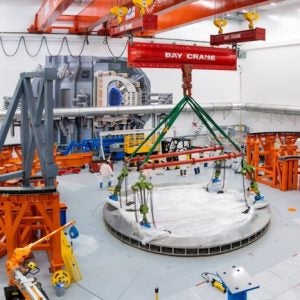 The first batch of used fuel assemblies from Russia’s Lepse floating technical base (PTB) was delivered to the Atomflot base in Murmansk, Russian state nuclear corporation Rosatom announced in late September.
The first batch of used fuel assemblies from Russia’s Lepse floating technical base (PTB) was delivered to the Atomflot base in Murmansk, Russian state nuclear corporation Rosatom announced in late September.
A total of 111 fuel assemblies, housed in six transport containers (TUKs), were delivered by the Serebryanka motor ship from the territory of the Nerpa Ship Repair Plant (SRZ). Removal of the used from from Lepse began at the Nerpa Shipyard in May. It took around three months to prepare the first batch of assemblies for transportation and during three weeks, the canisters were delivered to the pier, packed in TUKs and loaded onto the Serebryanka. In total, 639 fuel assemblies will be transported in six sailings.
Transportation of assemblies is one of the final stages of the disposal of the Lepse, which began in 2008. The work is being carried out supported by a grant of €53 million ($58m) from the Northern Dimension Environmental Partnership Support Fund (managed by the European Bank for Reconstruction and Development – EBRD). The EBRD said another five shipments of fuel will be completed by mid-2020 and that the the used fuel will later be moved for long term storage to the Mayak nuclear facility in the Urals.
“For many years, Lepse’s problems were considered insoluble,” said Deputy Director for State Policy for radioactive waste, used fuel and decommissioning of nuclear and radiation hazardous facilities (NROO) Vladimir Potsyapun, who also heads the project office of the Centre for International Programmes and Projects, dealing with radwaste, used fuel and decommissioning. “However, as a result of the work of representatives of more than 20 Rosatom enterprises, the Murmansk, Arkhangelsk, Leningrad Regions and the financial support of international organisations, today the used fuel unloading facility has been established and is functioning successfully.”
Vyacheslav Ruksha, Deputy General Director of Rosatom’s Northern Sea Route Directorate, said: “For me, the implementation of the international project for the disposal of the Lepse FTB is an extremely important and personal matter. Today is the most important event in the ecological rehabilitation of the region and the life of everyone who participated in this project.”
"The fuel removal process is an immensely challenging operation and the culmination of many years of international collaboration to address the legacy of the Lepse," said Simon Evans, associated director of nuclear safety at the European Bank for Reconstruction and Development. "The EBRD has managed the international support funds for over ten years to support the mitigation of this risk. Today is an important milestone in removing a serious danger to the people and the environment of Barents Sea region."
Dry cargo ship Lepse was built in 1934 and was converted into a floating technical base (PTB) in 1961. Until 1981, the PTB is resupplied nuclear fuel to nuclear icebreakers, but after 1981, it was used only for the storage of used nuclear fuel and radioactive waste and held 639 damaged and distorted nuclear fuel assemblies which represented a serious threat to the environment. It was decommissioned in 1988 and in 1996, the project to deal with it was included in the European Union’s TACIS programme (the CIS technical assistance programme) with funding allocated for the inspection of the used fuel.
In 2008, the initial executive grant agreement (GIS) was concluded for the disposal of the Lepse, the recipient of which was the Logistic Centre of the Nuclear Fuel Cycle, with the EBRD as the administrator. The aim of the project was to improve the radiation situation and eliminate serious environmental hazards in the region by removing used nuclear fuel and radioactive waste from the Lepse and sending it for reprocessing or temporary storage.
After 2011 with funding from Russia’s federal target programme “Ensuring Nuclear and Radiation Safety for 2008 and for the Period Until 2015”), a comprehensive radiation survey of the vessel was undertaken and preparatory work began. This included docking with partial conversion of the ship’s hull removing some radioactive material, decontamination, and installation of additional equipment. Lepse was then towed to the Nerpa Shipyard in 2012.
In September 2018, the EBRD announced it had built a shelter for refuelling the vessel intended to create safe conditions to cut out the used fuel from the onboard storage tanks, transfer the nuclear material into new canisters and transport these for further storage at Mayak. The EBRD said the cost of €23m shelter was financed through the Nuclear Window of the Northern Dimension Environmental Partnership Support Fund, an international fund with contributions from Belgium, Canada, Denmark, the European Union, Finland, France, Germany, the Netherlands, Norway and the UK, and managed by the EBRD.
Other projects financed by the fund include the supply of a system for the handling and transport of 22,000 spent fuel assemblies from a base in Andreeva Bay, built in the 1960s to service nuclear submarines of the former Soviet northern fleet, and the removal of spent nuclear fuel from reactors of Papa-class nuclear-powered submarines.
Photo: The first batch of spent nuclear fuel transport containers from Nerpa Shipyard (Credit: EBRD)






